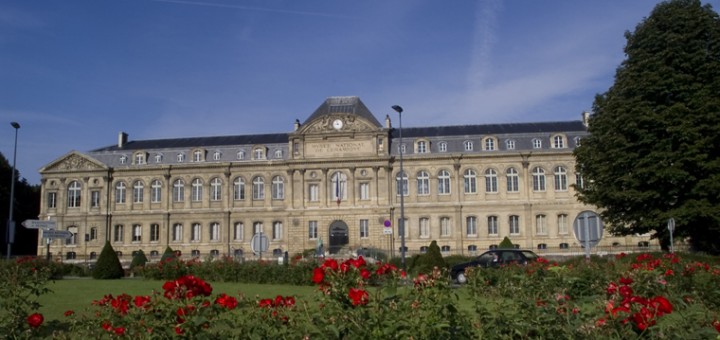2021 Année Napoléon > Sèvres – Manufacture et musée nationaux (Sevres manufactory and national museum)
 To mark this Year commemorating Napoleon, Sèvres – the National Manufactory and Museum invites you to discover some of the productions made by the Sèvres Manufacture for the Emperor Napoleon I, with a series of videos entitled “Sèvres au service de l’Empereur” [“Sèvres in the service of the Emperor”], which will be published on its social networks from 5 May 2021.
To mark this Year commemorating Napoleon, Sèvres – the National Manufactory and Museum invites you to discover some of the productions made by the Sèvres Manufacture for the Emperor Napoleon I, with a series of videos entitled “Sèvres au service de l’Empereur” [“Sèvres in the service of the Emperor”], which will be published on its social networks from 5 May 2021.
website of the manufactory and museum.
Update 6 April 2021
Digital programme
From 5 May 2021
A series of videos in several episodes will present some of the key works from the Sèvres Museum’s collections dating from this period. Each video will be devoted to a specific theme:
– the Etruscan scroll vase ;
– the Egyptian service ;
– the Emperor’s personal service (service particulier);
– the Emperor’s gifts (services and cabarets);
– the Percier clock;
– and finally the links between Brongniart and the Imperial administration.
Six videos will be published on the social networks of Sèvres – Manufacture et Musée Nationaux. The first video will be available on 5 May, the anniversary of the death of Emperor Napoleon I.
Also on this date, some of the videos, whose works are exhibited in the museum’s permanent tour, will be accessible to museum visitors by scanning a QR code placed next to the work.
→ Facebook of the Manufactory and museum
→ Twitter of the Manufactory and museum
→ YouTube of the Manufactory and museum
→ Instagram of the Manufactory and museum

© Gérard Jonca / Sèvres – Manufacture et Musée nationaux
Presentation: Sèvres in the service of the Emperor
In 1800 the Manufactory de Sèvres was struggling to survive. The fall of the monarchy and the throes of the Revolution had left it in a deplorable state. The brother of the 1st Consul, Lucien Bonaparte, then Minister of the Interior, decided to restore the lustre to this sleeping beauty and to transform it into a school of art. He had two thirds of the staff dismissed and appointed a young scientist, Alexandre Brongniart, as director. In just a few years, this mining engineer, with no experience of management or ceramics but a man of the Enlightenment, methodical and curious, brilliantly succeeded in his mission.
In 1805, the Manufacture became part of the Imperial Household and worked almost exclusively for the Emperor. Napoleon absorbed almost all the production for his palaces, for family gifts and diplomatic presents. With the exception of a few specific orders from Napoleon, Brongniart nevertheless retained great artistic freedom and chose the subjects and forms to be sent to the Court. He knew how to please and anticipated the Emperor’s needs. The quantities available were always sufficient to meet the demands as quickly as possible. As for the themes, they were often propaganda-related, direct (with portraits or historical facts linked to the reign) but also more pictorial with illustrations of places visited by Bonaparte.
The Manufacture was thus used as a political instrument. It contributed to the splendour of the court and also served as a model for other manufacturies, in France and abroad.
The expansion of the Empire, thanks to military victories and the installation of the Bonapartes on the various European thrones, implied an artistic extension of French art: the KPM manufactory in Berlin was subordinated to Sèvres from 1806 to 1815, Ginori in Tuscany, where Napoleon’s sister Elisa Bacciocchi reigned, copied the Sevres models, as did the Fürstenberg manufactory in Westphalia, governed by Jérome Bonaparte. While Brongniart advised these manufacturies on his travels to Germany and Austria, he also returned with technical processes on paste or porcelain for his future museum, which was intended to be a repertoire of forms, decorations and techniques.
The Manufactory is no longer a secret place, it no longer cultivates the “entre-soi” but the taste for perfection so dear to Napoleon. With the Empire and Brongniart, perfection at Sevres became technical, aesthetic and educational.
GENERAL INFORMATION
List of partners of “2021 Année Napoléon”.
Follow the special Instagram account for “2021 Année Napoléon” events.
Follow the Fondation Napoléon’s Facebook page in English.
Follow the Fondation Napoléon on Twitter.
Consult the page of the partner publishers and their published or republished works
on the occasion of the bicentenary of Napoleon’s death.
Subscribe to our free weekly newsletter (French or English).
